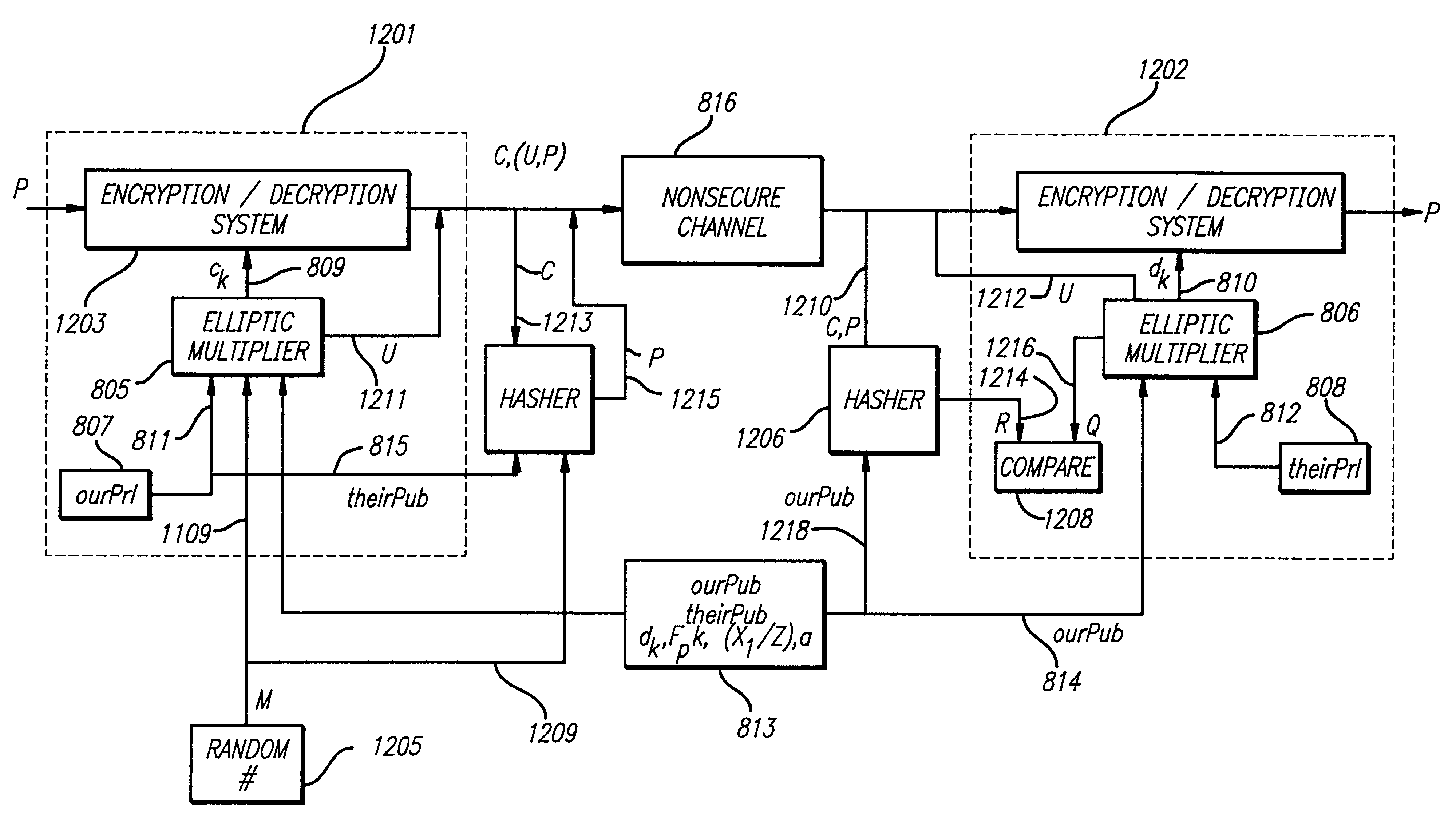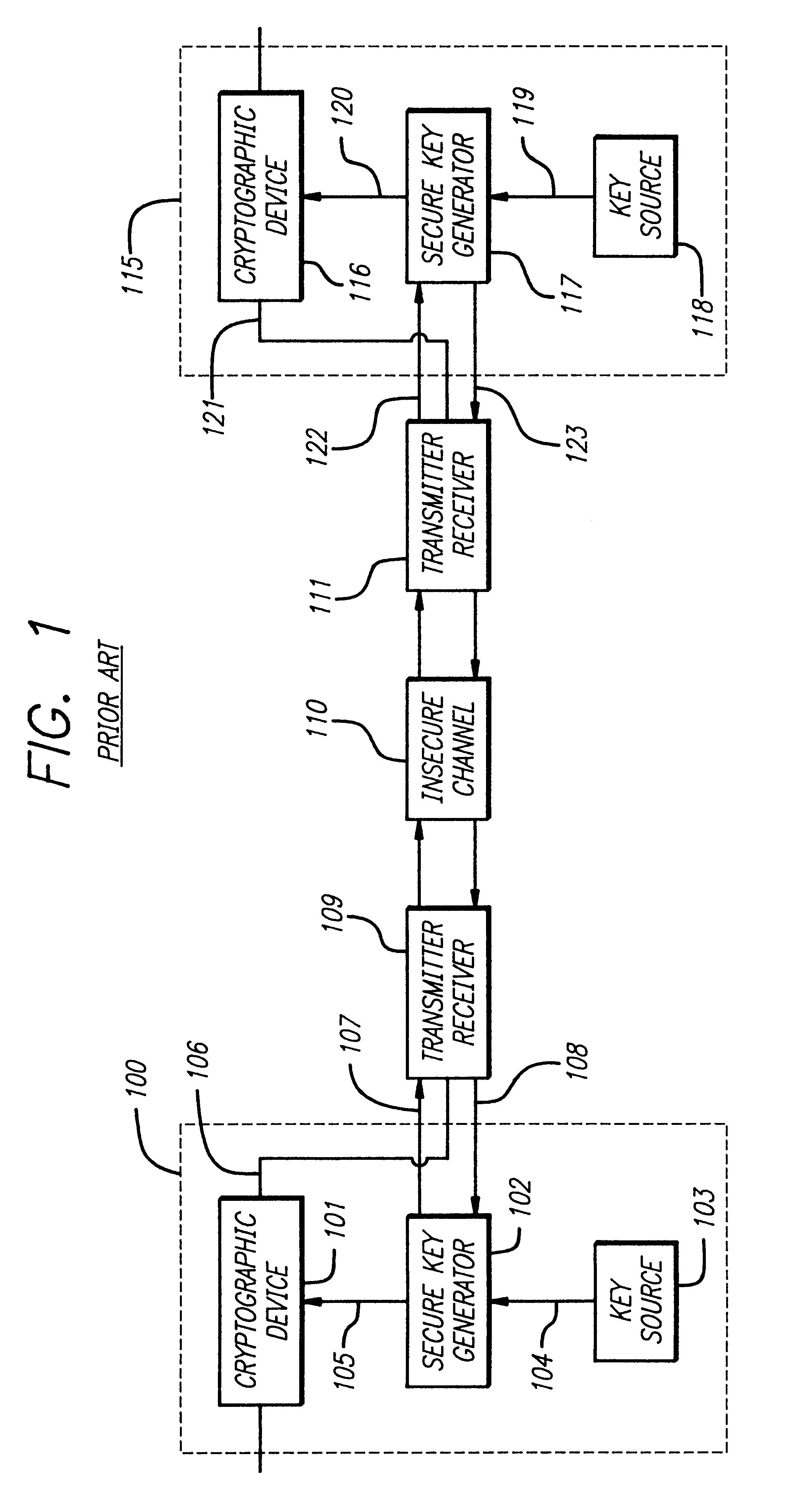Method and apparatus for fast elliptic encryption with direct embedding
a technology of elliptic encryption and embedding, applied in the field of cryptographic systems, can solve the problems of difficult or computationally infeasible computation of the inverse of the encrypting transformation function, impracticality and cost of secure channels, and the like, and achieves the effect of re-creating the encryption key from this information, and avoiding the loss of the encryption key
- Summary
- Abstract
- Description
- Claims
- Application Information
AI Technical Summary
Problems solved by technology
Method used
Image
Examples
example 2
Mersenne Prime (mod p) Arithmetic
In the present invention, when p is a Mersenne prime where p=2.sup.q -1, the (mod p) arithmetic can be accomplished using only shifts and adds, with no division required. Consider again n (mod p) where n is 3,991,652,149 and p is 127. When p is 127, q is equal to 7, from p=2.sup.q -1; 127=2.sup.7 -1=128 127.
The (mod p) arithmetic can be accomplished by using the binary form of n, namely 11101101111010111100011100110101. Referring to FIG. 5, the shifts and adds are accomplished by first latching the q least significant bits (LSB's) 501 of n, namely 0110101. The q LSB's 502 of the remaining digits, namely 0001110, are then added to q digits 501, resulting in sum 503 (1000011). The next q LSB's 504 of n, (0101111), are added to sum 503, generating sum 505, (1110010). Bits 506 of n (1101111) are added to sum 505, to result in sum 507, (11100001).
The remaining bits 508 (1110), even though fewer in number than q bits, are added to sum 507 to generate sum 5...
example 3
Fermat Number (mod p) Arithmetic
In the present invention, when p is a Fermat number where p=2.sup.q +1, the (mod p) arithmetic can be accomplished using only shifts, adds, and subtracts (a negative add), with no division required. Consider again n (mod p) where n is 3,991,652,149 and where p is now 257. When p is 257, q is equal to 8, from p=2.sup.q +1;257=2.sup.8 +1=256+1=257.
The (mod p) arithmetic can be accomplished by using the binary form of n, namely 11101101111010111100011100110101. Referring to FIG. 6, the shifts and adds are accomplished by first latching the q (8) least significant bits (LSB's) 601 (00110101). The next q LSB's 602 of the remaining digits, namely 11000111, are to be subtracted from q digits 601. To accomplish this, the 1's complement of bits 602 is generated and a 1 is added to the MSB side to indicate a negative number, resulting in bits 602' (100111000). This negative number 602' is added to bits 601 to generate result 603 (101101101). The next q LSB's 60...
example 4
Fast Class Mod Arithmetic
In the present invention, when p is a number of the class p=2.sup.q -C, where C is and odd number and is relatively small, (e.g. no greater than the length of a digital word), the (mod p) arithmetic can be accomplished using only shifts and adds, with no division required. Consider again n (mod p) where n is 685 and where p is 13. When p is 13, q is equal to 4 and C is equal to 3, from p=2.sup.q -C; 13=2.sup.4 -3=16-3=13.
The (mod p) arithmetic can be accomplished by using the binary form of n, namely 1010101101. Referring to FIG. 7, the shifts and adds are accomplished by first latching the q (4) least significant bits (LSB's) 701 of n, namely 1101. The remaining bits 702 (101010) are multiplied by C (3) to generate product 703 (1111110). Product 703 is added to bits 701 to generate sum 704 (10001011). The q least significant bits 705 (1011) of sum 704 are latched. The remaining bits 706 (1000) are multiplied by C to generate product 707 (11000). Product 707...
PUM
 Login to View More
Login to View More Abstract
Description
Claims
Application Information
 Login to View More
Login to View More - R&D
- Intellectual Property
- Life Sciences
- Materials
- Tech Scout
- Unparalleled Data Quality
- Higher Quality Content
- 60% Fewer Hallucinations
Browse by: Latest US Patents, China's latest patents, Technical Efficacy Thesaurus, Application Domain, Technology Topic, Popular Technical Reports.
© 2025 PatSnap. All rights reserved.Legal|Privacy policy|Modern Slavery Act Transparency Statement|Sitemap|About US| Contact US: help@patsnap.com



